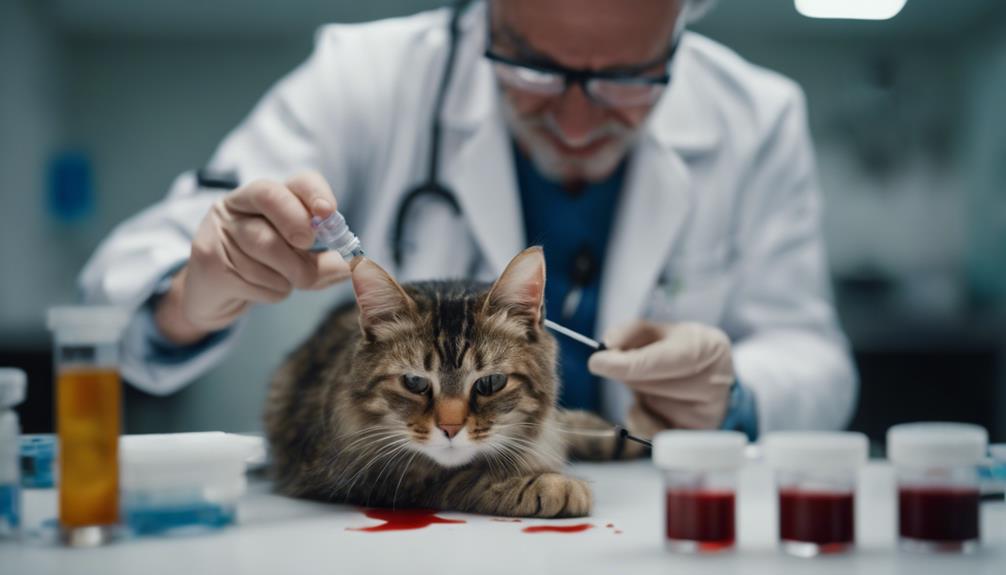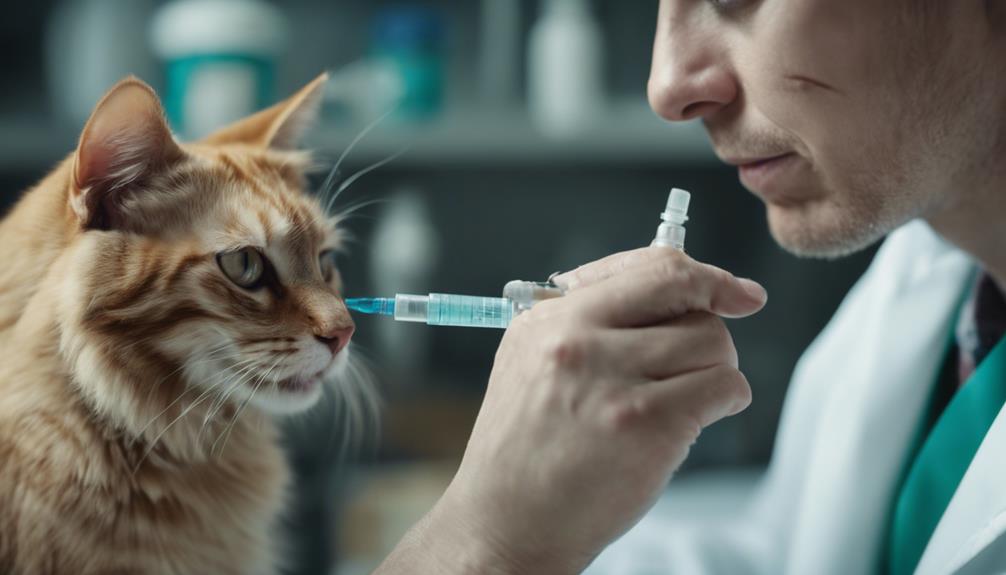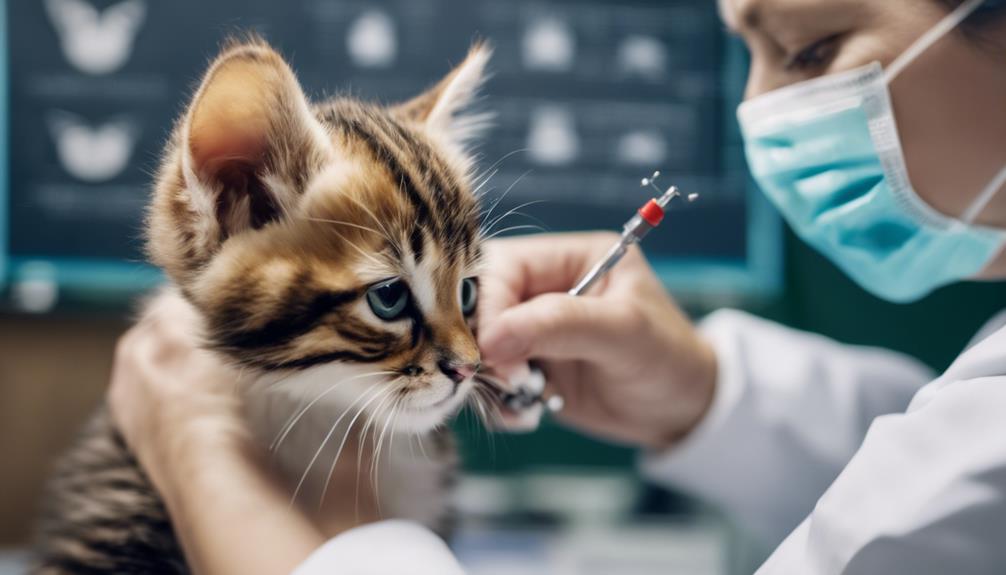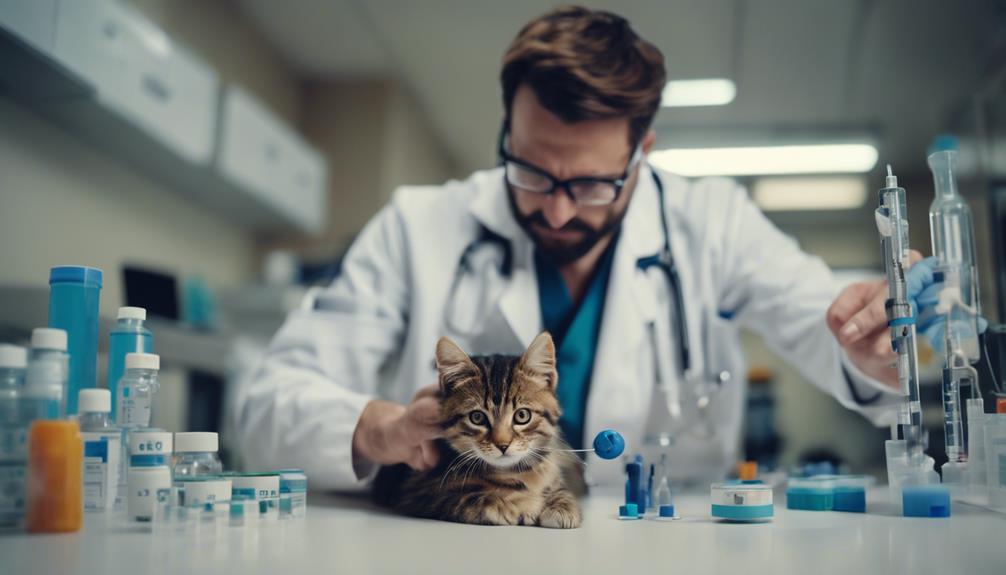An understanding of the threat posed by feline panleukopenia, also known as feline distemper or parvo, is crucial for cat owners and veterinary professionals alike.
The ramifications of this viral disease go beyond the surface symptoms, delving into the very core of a cat's immune system.
As we navigate the intricate landscape of feline health, uncovering the nuances of panleukopenia becomes imperative in safeguarding our feline companions.
Stay tuned to unravel the layers of this intricate feline disease and discover the key insights needed to protect your beloved cats.
Key Takeaways
- Feline panleukopenia is a highly contagious disease caused by the feline parvovirus.
- Symptoms include lack of appetite, diarrhea, vomiting, and dehydration.
- Vaccination is crucial in preventing panleukopenia and reducing its severity.
- Early detection and treatment significantly improve a cat's chance of survival.
Feline Panleukopenia Overview
In the realm of feline health, understanding the fundamental aspects of Feline Panleukopenia is crucial for maintaining the well-being of our feline companions.
This disease, characterized by a low count of white blood cells, is caused by the feline parvovirus, which targets rapidly growing cells in the body. Highly contagious and species-specific, this virus particularly affects kittens.
White blood cells play a vital role in protecting a cat's bloodstream from diseases, making the impact of panleukopenia significant. By grasping the essence of this condition, cat owners can better safeguard their pets and ensure prompt medical attention if needed.
Vigilance and preventive measures are key in combating this potentially fatal disease.
Signs and Symptoms of Infection
What are the common signs and symptoms indicative of feline panleukopenia infection?
- Lack of appetite
- Diarrhea
- Vomiting
Feline panleukopenia, also known as feline distemper or parvo, presents with various symptoms that can indicate infection. Cats affected by this disease may exhibit a lack of appetite, leading to weight loss and lethargy. Diarrhea and vomiting are also common signs of panleukopenia infection, often accompanied by fever and dehydration.
Recognizing these symptoms early on is crucial for seeking prompt veterinary care to improve the chances of successful treatment and recovery. If you notice any of these signs in your cat, it is essential to consult with a veterinarian for proper diagnosis and management.
Diagnosis and Testing Methods

Upon observing signs and symptoms suggestive of feline panleukopenia infection in a cat, veterinarians employ specific diagnostic and testing methods to confirm the presence of the disease.
The primary diagnostic tool for feline panleukopenia is a blood test, which can detect the presence of the feline parvovirus. This test helps veterinarians distinguish panleukopenia from other similar conditions. Additionally, veterinarians may consider the cat's vaccination history and potential contact with infected cats when making a diagnosis.
In some cases, further testing, such as PCR (polymerase chain reaction) tests, may be necessary for confirmation. Prompt and accurate diagnosis is crucial for initiating appropriate treatment and preventing the spread of the disease within the feline population.
Treatment Options Available
Effective management of feline panleukopenia involves a comprehensive approach that addresses both supportive care and targeted interventions to combat the disease. When treating a cat with panleukopenia, veterinarians may employ the following strategies:
- Supportive Care: Providing IV fluids to prevent dehydration and maintain electrolyte balance.
- Antibiotics: Administering antibiotics to prevent secondary bacterial infections.
- Anti-nausea Medication: Offering medication to alleviate vomiting and improve the cat's comfort.
These treatment options aim to support the cat's immune system, combat the feline parvovirus, and manage the symptoms associated with the disease. Prompt veterinary care and close monitoring are crucial in improving the cat's chances of recovery.
Understanding the Feline Vaccine

When managing feline panleukopenia, a key component lies in understanding the importance and efficacy of the feline vaccine. Vaccination plays a crucial role in preventing this deadly disease caused by the feline parvovirus.
The feline panleukopenia vaccine is typically administered as part of kittens' core vaccine schedule at 8, 12, and 16 weeks. Studies show that this vaccine significantly reduces the risk of infection and can save lives by either preventing the disease altogether or decreasing its severity if contracted.
Vaccine Schedule and Administration
Commencing a comprehensive vaccination program is essential for safeguarding feline health against panleukopenia, beginning with a strategic schedule and precise administration.
- The vaccine is typically included in kittens' core vaccine schedule at 8, 12, and 16 weeks.
- Proper administration by a trained professional ensures the vaccine's effectiveness.
- Following the recommended schedule and not missing any doses is crucial for optimal protection.
Importance of Vaccination in Cats

Vaccination plays a pivotal role in safeguarding feline health by bolstering immunity against preventable diseases. In the case of feline panleukopenia, timely vaccination is crucial in protecting cats from this highly contagious and potentially fatal virus.
The feline panleukopenia vaccine is a cornerstone in feline healthcare, forming part of the core vaccine schedule for kittens at 8, 12, and 16 weeks of age. By ensuring that cats are up to date with their vaccinations, owners can significantly reduce the risk of their feline companions contracting this devastating disease.
Vaccination not only helps prevent the illness but also diminishes the severity of symptoms if a vaccinated cat does become infected, highlighting the life-saving impact of routine immunization.
Preventing Spread and Transmission
To effectively control the spread of feline panleukopenia, implementing stringent hygiene protocols is imperative in minimizing the transmission of the highly contagious virus among cats.
Regularly clean and disinfect living areas, litter boxes, and food/water bowls to eliminate viral particles.
Isolate infected cats to prevent contact with healthy cats.
Wash hands thoroughly between handling cats, especially if moving from an infected to an uninfected cat.
Early Intervention for Better Outcomes

For optimal outcomes in feline panleukopenia cases, timely intervention is paramount to mitigate the severity of the disease and enhance the chances of survival for affected cats.
Early detection of feline panleukopenia symptoms, such as lack of appetite, diarrhea, vomiting, and dehydration, is crucial. If you notice any of these signs in your cat, swift action is essential.
Contact your veterinarian immediately for a thorough examination and prompt treatment. With feline panleukopenia, time is of the essence, and quick intervention can make a significant difference in the cat's recovery process.
Frequently Asked Questions
Can Feline Panleukopenia Be Transmitted to Other Animals Besides Cats?
Feline panleukopenia, caused by the feline parvovirus, is not transmissible to animals other than cats. Understanding its species-specific nature is crucial for effective control and preventive measures within feline populations.
Are There Any Long-Term Effects on Cats Who Survive a Bout With Feline Panleukopenia?
Surviving feline panleukopenia can have long-term effects on cats, including weakened immune systems, gastrointestinal issues, and potential infertility. Regular veterinary check-ups are essential to monitor and address any lingering health concerns post-recovery.
Is There a Correlation Between a Cat's Age and Their Susceptibility to Feline Panleukopenia?
Susceptibility to feline panleukopenia varies with age due to immune system strength. Young kittens are most vulnerable, as their immune systems are not fully developed. Older cats may have reduced immunity, making them susceptible as well. Vaccination is critical for all age groups.
Are There Any Alternative or Complementary Treatments That Can Be Used Alongside Traditional Veterinary Care for Panleukopenia?
While traditional veterinary care is essential for feline panleukopenia, alternative treatments like probiotics, immune-boosting supplements, and supportive therapies may complement medical interventions. Consult with a veterinarian to discuss suitable options for comprehensive care.
How Effective Is the Feline Panleukopenia Vaccine in Preventing the Disease in Outdoor Cats Versus Indoor Cats?
The efficacy of the feline panleukopenia vaccine in preventing the disease varies between outdoor and indoor cats due to exposure risks. Vaccination is crucial for both, with outdoor cats facing higher exposure rates, emphasizing the importance of preventive measures.
Conclusion
In conclusion, feline panleukopenia, also known as feline distemper or parvo, poses a significant threat to the health and well-being of cats. Understanding the signs, symptoms, diagnosis, treatment options, and the importance of vaccination is crucial in preventing the spread of this contagious and potentially fatal disease.
Early intervention and adherence to vaccination schedules are key in protecting the feline population from the detrimental effects of panleukopenia.




